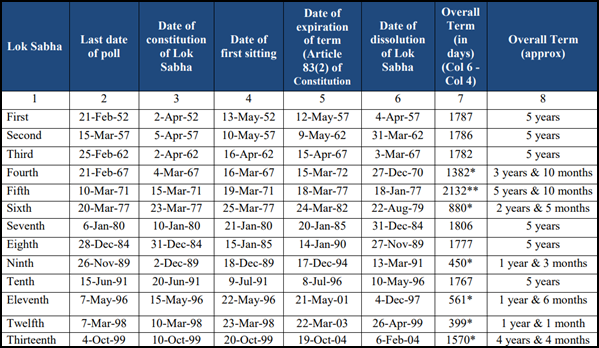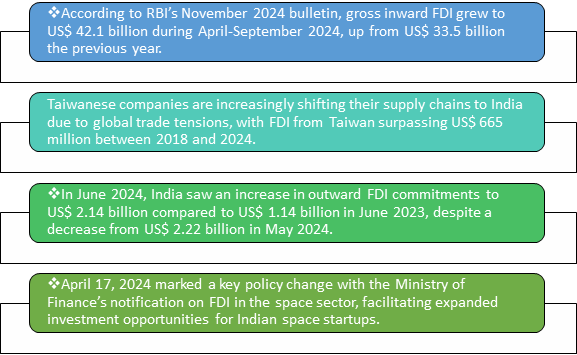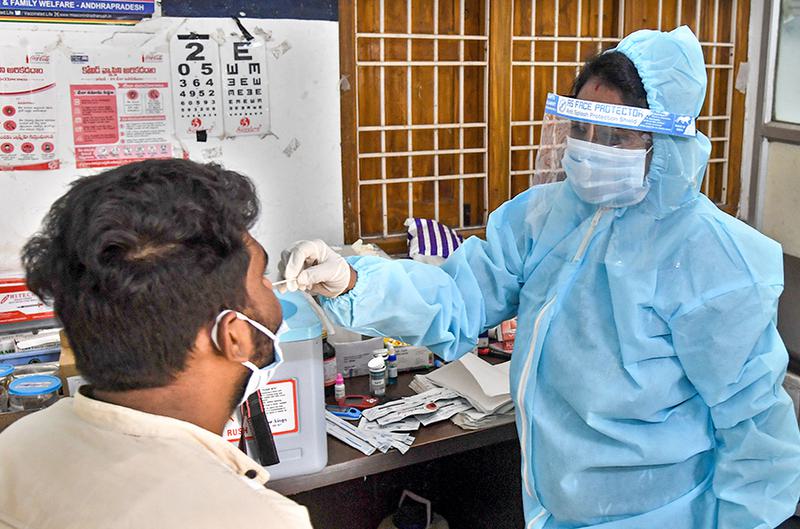One Nation, One Election Bill

- 13 Dec 2024
In News:
The One Nation, One Election Bill has made significant progress in India, passing the Lok Sabha with 269 votes in favor and 198 votes against. The bill proposes the synchronization of elections for the Lok Sabha, State Legislative Assemblies, and local bodies (Panchayats and Municipalities), aiming to streamline the electoral process, reduce costs, and enhance governance.
Key Updates:
- The bill has been approved by the Union Cabinet and will be reviewed by a Joint Parliamentary Committee (JPC), whose report will be presented for further approval and discussion in Parliament.
- The process will unfold in two phases:
- Phase 1: Simultaneous elections for the Lok Sabha and State Legislative Assemblies.
- Phase 2: Synchronizing local body elections (Panchayats and Municipalities) within 100 days of the general elections.
Historical Context:
- 1951-1967: India previously conducted simultaneous elections for the Lok Sabha and State Assemblies until disruptions, such as premature dissolutions of assemblies, led to staggered elections after 1967.
- The One Nation One Election concept has been revived to address inefficiencies in the current system, especially the high cost of conducting frequent elections.
Advantages of the One Nation, One Election Bill:
- Cost Reduction: Synchronizing elections can significantly lower the financial burden by eliminating the need for multiple election cycles, reducing the deployment of resources like security personnel and election staff.
- Long-Term Governance Focus: Politicians can prioritize governance and policy implementation rather than election campaigning, fostering long-term stability.
- Increased Voter Turnout: Voter fatigue, caused by frequent elections, may reduce, leading to higher turnout as elections occur less often.
- Fairer Political Competition: Smaller regional parties could have a better chance to compete with larger national parties by reducing election-related costs.
- Efficient Use of Resources: Security forces and administrative resources can be deployed more effectively, avoiding the redundancy caused by multiple election cycles.
Disadvantages of the One Nation, One Election Bill:
- Synchronization Challenges: Aligning elections across a vast and diverse country like India, especially in states with unstable political situations, may prove difficult.
- Federalism Concerns: The implementation may require constitutional changes that could impact India's federal structure, potentially limiting the autonomy of states in election matters.
- Impact on Regional Issues: National issues could overshadow regional concerns, diluting the focus on state-specific matters.
- Challenges for Regional Parties: Larger national parties may dominate the electoral landscape, reducing the influence of regional parties and undermining the federal nature of the political system.
- Accountability Risks: Fixed terms without frequent elections might reduce public scrutiny of elected officials, affecting their accountability.
Constitutional Amendments Required:
The implementation of One Nation, One Election requires amendments to several key constitutional provisions:
- Article 83: Regarding the duration of the Lok Sabha, amendments are needed to synchronize the timing of dissolution.
- Article 85: Deals with the sessions and dissolution of Parliament, which needs to be aligned with the new system.
- Article 172: Pertains to the duration of State Legislatures, requiring amendments for synchronization.
- Article 174: Similar to Article 85, it governs the sessions and dissolution of State Legislatures, needing standardization.
Implementation Challenges:
- Logistical Complexity: Conducting simultaneous elections would require immense logistical coordination, including vast numbers of electronic voting machines and trained personnel.
- Political Accountability: Fixed terms may reduce the accountability that frequent elections bring, potentially leading to governance stagnation.
- Impact on Federalism: Amendments to the Constitution regarding state legislatures might face resistance from states concerned about their autonomy.
International Mountain Day 2024
- 13 Dec 2024
In News:
On 11th December 2024, the Ministry of Environment, Forest and Climate Change, in collaboration with the International Union for Conservation of Nature (IUCN) and G.B. Pant National Institute of Himalayan Environment (NIHE), hosted an event titled ‘Youth for the Himalaya: Innovate, Inspire, Impact’ to mark International Mountain Day.
Event Overview:
- The event was themed “Mountain Solutions for a Sustainable Future – Innovation, Adaptation, and Youth.”
- It emphasized the critical role of young people in addressing the environmental challenges faced by the Indian Himalayan Region (IHR).
- The aim was to showcase youth-driven innovations contributing to the region's sustainability, catalyzing active youth participation in environmental actions. This initiative aligns with the Mission LiFE (Lifestyle for Environment), launched by Prime Minister Narendra Modi, which encourages sustainable practices and collective environmental responsibility.
Key Highlights:
- Young changemakers, innovators, and stakeholders from across the country participated, including students, youth representatives, and members of the private sector, civil society, and government.
- The event highlighted discussions on sustainable solutions for the Himalayan region, integrating traditional knowledge with modern technological advancements in areas like eco-tourism, biodiversity conservation, and climate resilience.
- Short films and videos produced by NIHE and IUCN, such as "Promoting Conservation of Threatened Plant Species in the Western Himalayas" and "Himalayan Futures: Voices from the Ground," were also showcased.
International Mountain Day
- International Mountain Day, observed every year on December 11th since 2003, was established by the United Nations to raise awareness about the sustainable development of mountain regions.
- Mountains cover about one-fifth of the Earth's surface and provide essential freshwater to half of humanity, supporting agriculture, clean energy, and health.
Indian Himalayan Region (IHR)
- The IHR spans 13 Indian states and union territories, stretching approximately 2,500 kilometers from west to east. It is a biodiversity hotspot with significant ecological and cultural value. However, it faces challenges such as unsustainable development, climate change impacts, cultural erosion, and rising tourism.
Key Concerns for IHR:
- Unsustainable Development: Infrastructure projects and deforestation disrupt ecosystems.
- Climate Change: Glacial melting and rising temperatures affect water resources and increase flood risks.
- Cultural Erosion: Modernization threatens traditional practices of indigenous communities.
- Tourism Pressure: Waste generation due to growing tourism puts immense pressure on the region's fragile ecology.
Measures for Protection:
- Sustainable Tourism: Promoting eco-tourism and enforcing capacity limits to minimize environmental impact.
- Water Management: Capturing glacial meltwater for agriculture and ecosystem support.
- Disaster Preparedness: Developing disaster management strategies and early warning systems for events like landslides and floods.
- Bio-Cultural Conservation: Protecting both natural biodiversity and indigenous cultural practices through designated zones.
- Integrated Development: Establishing a "Himalayan Authority" for coordinated development in line with Sustainable Development Goals.
India’s Foreign Direct Investment (FDI) Journey Hits $1 Trillion Milestone

- 13 Dec 2024
In News:
India has reached a historic milestone, surpassing $1 trillion in foreign direct investment (FDI) inflows since April 2000. This achievement highlights India’s growing status as a major global investment hub and is further validated by a 26% increase in FDI inflows, which reached $42.1 billion during the first half of FY 2024-25.
Key Highlights of India’s FDI Growth:
- $1 Trillion Milestone: India has attracted a total of $1 trillion in FDI from April 2000 to September 2024. This figure includes equity, reinvested earnings, and other capital inflows.
- 26% Growth in FDI: FDI inflows surged by 26% in the first half of FY 2024-25, totaling $42.1 billion.
- Top Investors: Major investors include Mauritius (25%), Singapore (24%), and the United States (10%). These countries benefit from favorable tax treaties with India, boosting investment.
- Dominant Sectors: FDI has flowed into sectors like services, manufacturing, technology, and telecommunications, with significant investments also in pharmaceuticals, automobile, and construction development.
Factors Behind India’s FDI Success:
- Policy Reforms: India’s liberalized FDI policies, such as allowing 100% FDI in most sectors under the automatic route, have attracted foreign capital. Key reforms like abolishing angel tax and reducing corporate tax rates in the Income Tax Act of 2024 have also enhanced investor confidence.
- Business Environment: India’s rise in global competitiveness is evident in its improvement in rankings. It moved from 43rd to 40th in the World Competitiveness Index 2024 and climbed to 40th in the Global Innovation Index 2023, up from 81st in 2015.
- Investor Confidence: The government’s efforts, including initiatives like "Make in India", Goods and Services Tax (GST), and sector-specific incentives, have fostered a conducive environment for investment.
- Global Investment Standing: India has been the third-largest recipient of greenfield projects globally and saw a 64% increase in international project finance deals.
Contribution of Mauritius and Singapore:
- Mauritius and Singapore lead as the primary sources of FDI into India. Their favorable tax treaties with India make them attractive gateways for foreign investments. Mauritius accounted for 25%, and Singapore for 24% of the total FDI inflows.
Key Sectors Attracting FDI:
- Services Sector: Significant growth in services, especially financial services, has attracted substantial foreign investments.
- Manufacturing and Technology: These sectors have benefited from policies like the Production-Linked Incentive (PLI) schemes, which encourage foreign investments in high-tech manufacturing.
- Telecommunications and Pharmaceuticals: India’s growing digital ecosystem and strong pharmaceutical industry continue to attract international investments.
Importance of FDI for India:
- Infrastructure Development: FDI plays a crucial role in financing infrastructure projects, helping meet the country’s significant infrastructure needs.
- Balance of Payments: FDI helps bridge India’s current account deficit, ensuring stable foreign exchange reserves.
- Technology Transfer and Employment: Foreign investments bring advanced technology and create jobs, boosting productivity across sectors.
- Currency Stability: FDI supports the Indian Rupee in global markets by injecting foreign capital.
Challenges:
Despite the positive trends, India faces challenges such as geopolitical tensions, regulatory issues, global economic uncertainty, and infrastructure bottlenecks that can affect investor sentiment and capital inflows.
Way Ahead:
- Focus on Infrastructure: Continued investment in infrastructure development, including public-private partnerships (PPPs), will be crucial for sustained economic growth.
- Workforce Skilling: Collaborative efforts to upskill the workforce will ensure that India can meet the evolving demands of industries.
- Research and Development: Strengthening R&D and innovation will enhance India’s productivity and global competitiveness.
2024 World Chess Championship

- 13 Dec 2024
In News:
D. Gukesh became the youngest world chess champion after defeating Ding Liren of China in the final game of their match.
Key Facts about the 2024 World Chess Championship:
- Held At: Singapore, from November 25 to December 12, 2024.
- Players: Reigning champion Ding Liren (China) vs. Challenger D. Gukesh (India).
- Significance: This was the first-ever World Championship match contested by two Asian players. Gukesh became the third Asian to win the World Championship after Viswanathan Anand (India) and Ding Liren (China).
- Historical Context: The World Chess Championship was first established in 1886 with Wilhelm Steinitz as the first official World Champion.
- Governing Body: Organized by FIDE (Fédération Internationale des Échecs), which has been responsible for the event since 1948.
- Selection Process: Gukesh earned his spot through his victory in the 2024 Candidates Tournament in Toronto, while Ding Liren was the reigning champion after Magnus Carlsen declined to defend his title.
D. Gukesh: Key Details
- Birth: May 29, 2006, in Chennai, India.
- Grandmaster Title: Achieved at age 12 years, 7 months, and 17 days, making him the third-youngest Grandmaster in history.
- Chess Rating: He is the youngest player to reach a 2750 FIDE rating.
- Significant Wins:
- Gold medals in both team and individual events at the 2024 Chess Olympiad.
- Bronze medal in team events at the 2024 Asian Games.
- Remarkable Fact: Gukesh is four years younger than Garry Kasparov was when he won the World Championship in 1985.
FIDE World Chess Championship Overview:
- Founded: 1924 in Paris; headquartered in Lausanne, Switzerland.
- Governing Body: The International Chess Federation (FIDE) is recognized by the International Olympic Committee and governs global chess competitions. FIDE has 201 member countries.
Indian Chess Achievements:
- Viswanathan Anand: First Indian to win the World Chess Championship (5-time World Champion).
- D. Gukesh: Second Indian to win the World Chess Championship.
Disease X

- 13 Dec 2024
In News:
The recent outbreak reported in the first week of December 2024 in the Democratic Republic of Congo, which has claimed over 400 lives and remains unclassified, has raised concerns that it could be an instance of Disease X.
What is Disease X?
- Definition: Disease X is a hypothetical, unidentified pathogen that has the potential to cause a global health crisis, either as an epidemic or pandemic.
- Origins: Could arise from zoonotic spillover (animal-to-human transmission), antimicrobial resistance, bioterrorism, or lab accidents.
- Severity: Predicted to be 20 times more lethal than SARS-CoV-2, with rapid transmission and significant mortality.
- Features: Represents unknown threats, including viruses, bacteria, fungi, or prions.
- Emergence Factors: Driven by deforestation, urbanization, climate change, and human-wildlife interactions.
Historical Context
- Conceptualization: The term was coined by the World Health Organization (WHO) in 2018, post the 2014–2016 Ebola outbreak, which revealed gaps in global health responses.
- Zoonotic Origins: Around 70% of emerging diseases since 1940 have zoonotic origins, linked to human encroachment on wildlife habitats.
WHO’s Priority Pathogen List
- Purpose: To focus global resources and attention on diseases with high epidemic or pandemic potential but lacking sufficient vaccines or treatments.
- Pathogens Listed: Includes Ebola, Marburg, Lassa fever, Nipah virus, Rift Valley fever, Zika virus, and Disease X.
- Criteria: These diseases have high mortality rates, potential for rapid spread, and inadequate preventive or therapeutic options.
Why Disease X is a Concern
- Unpredictability: Its emergence, transmission, and impact remain uncertain, making preparedness challenging.
- Globalization: Increased global travel and trade facilitate rapid spread of diseases across borders.
- Environmental Drivers: Climate change, urbanization, and deforestation disrupt ecosystems, bringing humans into closer contact with wildlife and pathogens.
Patterns in Emerging Diseases
- Zoonotic Spillover: The majority of emerging diseases originate from animals, with over 1.7 million undiscovered viruses in wildlife that could infect humans.
- Increased Outbreaks: Since the mid-20th century, the frequency of new diseases has risen, reflecting environmental, demographic, and global factors.
Challenges in Predicting Disease X
- Uncertainty: The vast pool of potential pathogens (viruses, bacteria, fungi, etc.) makes it difficult to predict the exact nature, origin, or timing of Disease X.
- Environmental and Climatic Changes: Climate change reshapes disease transmission dynamics, expanding the range of diseases like malaria and dengue.
- Technological and Knowledge Gaps: Many pathogens that could cause pandemics are still unidentified. Genomic sequencing and AI are advancing but cannot fully predict Disease X.
Global Preparedness Initiatives
- WHO's Role: WHO’s priority pathogen list and Pandemic Treaty aim to ensure coordinated, global responses to future outbreaks.
- Pandemic Fund: Supports strengthening health systems, especially in low-income countries.
- mRNA Vaccine Hubs: Enhance vaccine production capacity, particularly in developing countries.
- Coalition for Epidemic Preparedness Innovations (CEPI): Works on "prototype pathogen" platforms to create vaccines within 100 days of identifying a new disease.
Indian Initiatives for Disease Surveillance and Preparedness
- Integrated Disease Surveillance Programme (IDSP): Tracks outbreaks, monitors trends, and strengthens the country’s epidemic preparedness.
- National Institute of Virology (NIV): Focuses on researching viral pathogens and zoonotic diseases.
- Biotech Initiatives: Indigenous vaccine development and diagnostic tools are crucial for combating future outbreaks.
- Emergency Response Fund: Allocates resources to support immediate pandemic response efforts.
Key Challenges in Tackling Disease X
- Prediction Complexity: The interactions between humans, animals, and the environment are too complex to predict the exact nature of Disease X.
- Health Disparities: Low- and middle-income countries often lack the infrastructure to effectively combat pandemics, making them more vulnerable.
- Climate Change: Alters transmission dynamics, expanding the range of diseases carried by vectors like mosquitoes.
Way Forward
- Strengthening Surveillance: Implementing real-time genomic sequencing and AI-driven tools for early outbreak detection.
- Global Cooperation: Promoting equitable sharing of vaccines, diagnostics, and treatments to ensure timely and efficient responses.
- Public Health Infrastructure: Invest in strengthening healthcare systems, especially in high-risk regions like the Congo Basin.
- Research and Development: Focus on universal vaccines, diagnostic tools, and prototype pathogen platforms that can be quickly adapted to new diseases.
